Single Photon Detectors单光子探测器-PPT文档资料
- 格式:ppt
- 大小:3.37 MB
- 文档页数:49
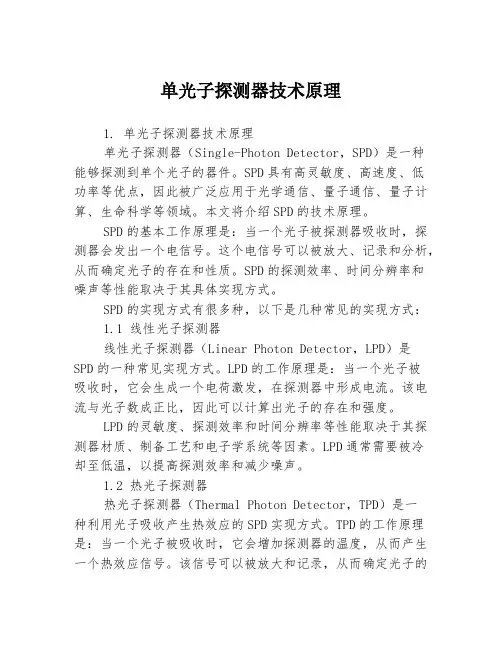
单光子探测器技术原理1. 单光子探测器技术原理单光子探测器(Single-Photon Detector,SPD)是一种能够探测到单个光子的器件。
SPD具有高灵敏度、高速度、低功率等优点,因此被广泛应用于光学通信、量子通信、量子计算、生命科学等领域。
本文将介绍SPD的技术原理。
SPD的基本工作原理是:当一个光子被探测器吸收时,探测器会发出一个电信号。
这个电信号可以被放大、记录和分析,从而确定光子的存在和性质。
SPD的探测效率、时间分辨率和噪声等性能取决于其具体实现方式。
SPD的实现方式有很多种,以下是几种常见的实现方式:1.1 线性光子探测器线性光子探测器(Linear Photon Detector,LPD)是SPD的一种常见实现方式。
LPD的工作原理是:当一个光子被吸收时,它会生成一个电荷激发,在探测器中形成电流。
该电流与光子数成正比,因此可以计算出光子的存在和强度。
LPD的灵敏度、探测效率和时间分辨率等性能取决于其探测器材质、制备工艺和电子学系统等因素。
LPD通常需要被冷却至低温,以提高探测效率和减少噪声。
1.2 热光子探测器热光子探测器(Thermal Photon Detector,TPD)是一种利用光子吸收产生热效应的SPD实现方式。
TPD的工作原理是:当一个光子被吸收时,它会增加探测器的温度,从而产生一个热效应信号。
该信号可以被放大和记录,从而确定光子的存在和强度。
TPD的探测效率、时间分辨率和噪声等性能取决于其探测器材质、制备工艺和热管理等因素。
TPD通常需要被冷却或控制温度,以提高探测效率和减少噪声。
1.3 光电倍增管光电倍增管(Photomultiplier Tube,PMT)是一种利用光电效应产生电子增益的SPD实现方式。
PMT的工作原理是:当一个光子被吸收时,它会产生一个光电子,光电子会在PMT 中加速并撞击光阴极,从而产生多个次级电子。
这些次级电子会再次加速并撞击下一个次级结构,如此反复,直到产生一个可以被读取的电信号。


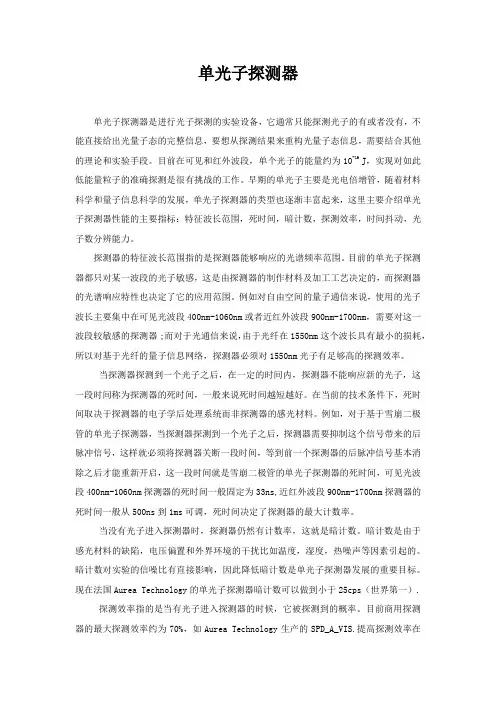
单光子探测器单光子探测器是进行光子探测的实验设备,它通常只能探测光子的有或者没有,不能直接给出光量子态的完整信息,要想从探测结果来重构光量子态信息,需要结合其他的理论和实验手段。
目前在可见和红外波段,单个光子的能量约为10-19 J,实现对如此低能量粒子的准确探测是很有挑战的工作。
早期的单光子主要是光电倍增管,随着材料科学和量子信息科学的发展,单光子探测器的类型也逐渐丰富起来,这里主要介绍单光子探测器性能的主要指标:特征波长范围,死时间,暗计数,探测效率,时间抖动,光子数分辨能力。
探测器的特征波长范围指的是探测器能够响应的光谱频率范围。
目前的单光子探测器都只对某一波段的光子敏感,这是由探测器的制作材料及加工工艺决定的,而探测器的光谱响应特性也决定了它的应用范围。
例如对自由空间的量子通信来说,使用的光子波长主要集中在可见光波段400nm-1060nm或者近红外波段900nm-1700nm,需要对这一波段较敏感的探测器;而对于光通信来说,由于光纤在1550nm这个波长具有最小的损耗,所以对基于光纤的量子信息网络,探测器必须对1550nm光子有足够高的探测效率。
当探测器探测到一个光子之后,在一定的时间内,探测器不能响应新的光子,这一段时间称为探测器的死时间,一般来说死时间越短越好。
在当前的技术条件下,死时间取决于探测器的电子学后处理系统而非探测器的感光材料。
例如,对于基于雪崩二极管的单光子探测器,当探测器探测到一个光子之后,探测器需要抑制这个信号带来的后脉冲信号,这样就必须将探测器关断一段时间,等到前一个探测器的后脉冲信号基本消除之后才能重新开启,这一段时间就是雪崩二极管的单光子探测器的死时间,可见光波段400nm-1060nm探测器的死时间一般固定为33ns,近红外波段900nm-1700nm探测器的死时间一般从500ns到1ms可调,死时间决定了探测器的最大计数率。
当没有光子进入探测器时,探测器仍然有计数率,这就是暗计数。

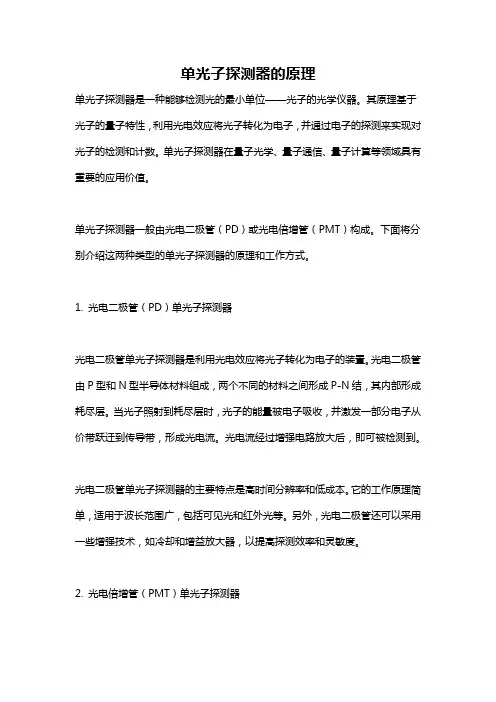
单光子探测器的原理单光子探测器是一种能够检测光的最小单位——光子的光学仪器。
其原理基于光子的量子特性,利用光电效应将光子转化为电子,并通过电子的探测来实现对光子的检测和计数。
单光子探测器在量子光学、量子通信、量子计算等领域具有重要的应用价值。
单光子探测器一般由光电二极管(PD)或光电倍增管(PMT)构成。
下面将分别介绍这两种类型的单光子探测器的原理和工作方式。
1. 光电二极管(PD)单光子探测器光电二极管单光子探测器是利用光电效应将光子转化为电子的装置。
光电二极管由P型和N型半导体材料组成,两个不同的材料之间形成P-N结,其内部形成耗尽层。
当光子照射到耗尽层时,光子的能量被电子吸收,并激发一部分电子从价带跃迁到传导带,形成光电流。
光电流经过增强电路放大后,即可被检测到。
光电二极管单光子探测器的主要特点是高时间分辨率和低成本。
它的工作原理简单,适用于波长范围广,包括可见光和红外光等。
另外,光电二极管还可以采用一些增强技术,如冷却和增益放大器,以提高探测效率和灵敏度。
2. 光电倍增管(PMT)单光子探测器光电倍增管单光子探测器是一种将光子转化为电子,并经过倍增放大后检测的装置。
光电倍增管由光阴极、电子倍增结构和阳极等组成。
光子照射到光阴极时,光子的能量被光阴极吸收,并激发出电子,形成初级电子。
初级电子被电子倍增结构中的一系列二次发射表面所吸收和发射,从而进行倍增,最终形成大量次级电子。
最后,次级电子被阳极吸收,并经过放大电路放大后即可被检测到。
光电倍增管单光子探测器的主要特点是高增益和低噪声。
光电倍增管具有高放大倍数和较低的附加噪声,因此能够检测到非常弱的光信号。
光电倍增管适用于宽范围的光谱,包括可见光、紫外光和一部分红外光等。
为了提高单光子探测器的性能,研究人员一直进行着一系列的改进工作。
例如,引入低温冷却技术可以降低器件的热噪声,并提高探测器的灵敏度。
此外,采用新型的材料和结构设计也可以进一步改善探测器的性能。
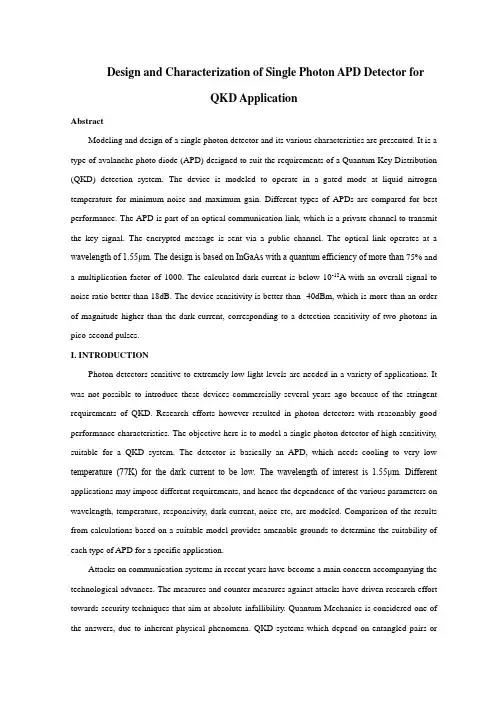
Design and Characterization of Single Photon APD Detector forQKD ApplicationAbstractModeling and design of a single photon detector and its various characteristics are presented. It is a type of avalanche photo diode (APD) designed to suit the requirements of a Quantum Key Distribution (QKD) detection system. The device is modeled to operate in a gated mode at liquid nitrogen temperature for minimum noise and maximum gain. Different types of APDs are compared for best performance. The APD is part of an optical communication link, which is a private channel to transmit the key signal. The encrypted message is sent via a public channel. The optical link operates at a wavelength of 1.55μm. The design is based on InGaAs with a quantum efficiency of more than 75% and a multiplication factor of 1000. The calculated dark current is below 10-12A with an overall signal to noise ratio better than 18dB. The device sensitivity is better than -40dBm, which is more than an order of magnitude higher than the dark current, corresponding to a detection sensitivity of two photons in pico-second pulses.I. INTRODUCTIONPhoton detectors sensitive to extremely low light levels are needed in a variety of applications. It was not possible to introduce these devices commercially several years ago because of the stringent requirements of QKD. Research efforts however resulted in photon detectors with reasonably good performance characteristics. The objective here is to model a single photon detector of high sensitivity, suitable for a QKD system. The detector is basically an APD, which needs cooling to very low temperature (77K) for the dark current to be low. The wavelength of interest is 1.55μm. Different applications may impose different requirements, and hence the dependence of the various parameters on wavelength, temperature, responsivity, dark current, noise etc, are modeled. Comparison of the results from calculations based on a suitable model provides amenable grounds to determine the suitability of each type of APD for a specific application.Attacks on communication systems in recent years have become a main concern accompanying the technological advances. The measures and counter measures against attacks have driven research effort towards security techniques that aim at absolute infallibility. Quantum Mechanics is considered one of the answers, due to inherent physical phenomena. QKD systems which depend on entangled pairs orpolarization states will inevitably require the usage of APDs in photon detection systems. How suitable these detectors may be, depends on their ability to detect low light level signals, in other words “photon counting”. It is therefore anticipated that the application of high security systems will be in high demand in a variety of fields such as banking sector, military, medical care, e-commerce, e-government etc.Ⅱ. AV ALANCHE PHOTO DIODEA. Structure of the APDFig. 1 shows a schematic diagram of the structure of an APD. The APD is a photodiode with a built-in amplification mechanism. The applied reverse potential difference causes accelerates photo-generated carriers to very high speeds so that a transfer of momentum occurs upon collisions, which liberates other electrons. Secondary electrons are accelerated in turn and the result is an avalanche process. The photo generated carriers traverse the high electric field region causing further ionization by releasing bound electrons in the valence band upon collision. This carrier generation mechanism is known as impact ionization. When carriers collide with the crystal lattice, they lose some energy to the crystal. If the kinetic energy of a carrier is greater than the band-gap, the collision will free a bound electron. The free electrons and holes so created also acquire enough energy to cause further impact ionization. The result is an avalanche, where the number of free carriers grows exponentially as the process continues.The number of ionization collisions per unit length for holes and electrons is designated ionization coefficients αn and αp, respectively. The type of materials and their band structures are responsible for the variation in αn and αp. Ionization coefficients also depend on the applied electric field according tothe following relationship:,exp[]n p b a Eαα=- (1) For αn = αp = α, the multiplication factor, M takes the form11aW M -= (2)W is the width of the depletion region. It can be observed that M tends to ∞ when αW →1, whichsignifies the condition for junction breakdown. Therefore, the high values of M can be obtained whenthe APD is biased close to the breakdown region.The thickness of the multiplication region for M = 1000, has been calculated and compared withthose found by other workers and the results are shown in Table 1. The layer thickness for undoped InPis 10μm, for a substrate thickness of 100μm .The photon-generated electron-hole pairs in the absorption layer are accelerated under theinfluence of an electric field of 3.105V/cm. The acceleration process is constantly interrupted by randomcollisions with the lattice. The two competing processes will continue until eventually an averagesaturation velocity is reached. Secondary electron-hole pairs are generated at any time during theprocess, when they acquire energy larger than the band gap Eg. The electrons are then accelerated andmay cause further impact ionization.Impact ionization of holes due to bound electrons is not as effective as that due to free electrons.Hence, most of the ionization is achieved by free electrons. The avalanche process then proceedsprincipally from the p to the n side of the device. It terminates after a certain time, when the electronsarrive at the n side of the depletion layer. Holes moving to the left create electrons that move to the right,which in turn generate further holes moving to the left in a possibly unending circulation. Although this feedback process increases the gain of the device, it is nevertheless undesirable for several reasons. First, it is time consuming and reduces the device bandwidth. Second, it is a random process and therefore increases the noise in the device. Third, it is unstable, which may cause avalanche breakdown.It may be desirable to fabricate APDs from materials that permit impact ionization by only one type of carriers either electrons or holes. Photo detector materials generally exhibit different ionization rates for electrons and holes. The ratio ofthe two ionization rates k = βi/αi is a measure of the photodiode performance. If for example, electrons have higher ionization coefficient, optimal behavior is achieved by injecting electrons of photo-carrier pairs at the p-type edge of the depletion layer and by using a material with k value as small as possible. If holes are injected, they should be injected at the n-type edge of the depletion layer and k should be as large as possible. Single-carrier multiplication is achieved ideally, when k = 0 with electrons or with k = ∞for holes.B.Geiger ModeGeiger mode (GM) operation means that the diode is operated slightly above the breakdown threshold voltage, where a single electron–hole pair can trigger a strong avalanche. In the case of such an event, the electronics reduce the diode voltage to below the threshold value for a short time called “dead time”, during which the avalanche is stopped and the detector is made ready to detect the next batch of photons. GM operation is one of the basic of Quantum Counting techniques when utilizing an avalanche process (APD) that increases the detector efficiency significantly.There are a number of parameters related to Geiger mode. The general idea however is to temporarily disturb the equilibrium inside the APD.The Geiger mode is placing the APD in a gated regime and the bias is raised above the breakdownvoltage for a short period of time. Fig. 2 shows the parameters characterizing the Geiger operation. The rise and fall times of the edges are neglected because they are made fast. Detection of single photons occurs during the gate window.作者:Khalid A. S. Al-Khateeb, Nazmus Shaker Nafi, Khalid Hasan国籍:美国出处:Computer and Communication Engineering (ICCCE), 2010 International Conference on 11-12 May 2010用于量子密钥的单光子APD探测器设计摘要本文提出的是单光子探测器及其各种特性的建模与设计。
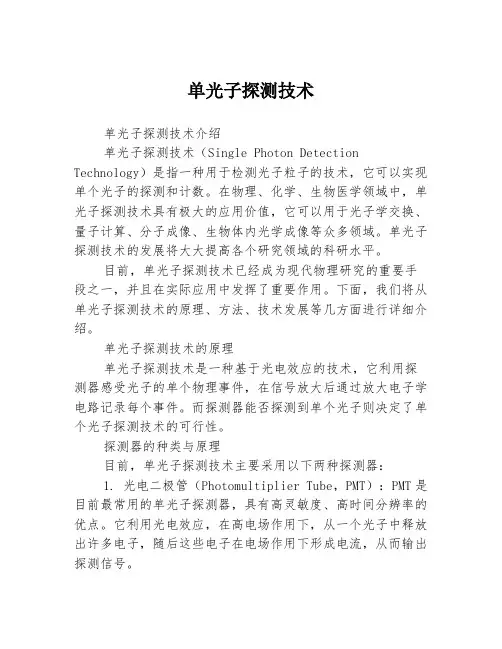
单光子探测技术单光子探测技术介绍单光子探测技术(Single Photon Detection Technology)是指一种用于检测光子粒子的技术,它可以实现单个光子的探测和计数。
在物理、化学、生物医学领域中,单光子探测技术具有极大的应用价值,它可以用于光子学交换、量子计算、分子成像、生物体内光学成像等众多领域。
单光子探测技术的发展将大大提高各个研究领域的科研水平。
目前,单光子探测技术已经成为现代物理研究的重要手段之一,并且在实际应用中发挥了重要作用。
下面,我们将从单光子探测技术的原理、方法、技术发展等几方面进行详细介绍。
单光子探测技术的原理单光子探测技术是一种基于光电效应的技术,它利用探测器感受光子的单个物理事件,在信号放大后通过放大电子学电路记录每个事件。
而探测器能否探测到单个光子则决定了单个光子探测技术的可行性。
探测器的种类与原理目前,单光子探测技术主要采用以下两种探测器:1. 光电二极管(Photomultiplier Tube,PMT):PMT是目前最常用的单光子探测器,具有高灵敏度、高时间分辨率的优点。
它利用光电效应,在高电场作用下,从一个光子中释放出许多电子,随后这些电子在电场作用下形成电流,从而输出探测信号。
图1 光电二极管2. 硅单光子探测器(Silicon Single Photon Detector,SSPD):SSPD是一种基于超导原理的单光子探测器,它具有高计数速度、高时间分辨率、宽光谱响应等优点。
SSPD的探测原理是基于光子的到来会产生热能,并引起超导材料中的超导态损耗,从而造成电压变化,探测单个光子信号。
SSPD的响应时间通常在几十皮秒以内。
图2 硅单光子探测器探测器的性能主要受到噪声和分辨率的影响。
其中噪声主要来自于热电子噪声、暗计数噪声和光电倍增管烷基噪声等,因此,在单光子探测技术中通常采用探测器阵列的方法,将多个探测器阵列进行综合测量,以提高信噪比,降低噪声,并实现高灵敏度、高时间分辨率的单光子探测。
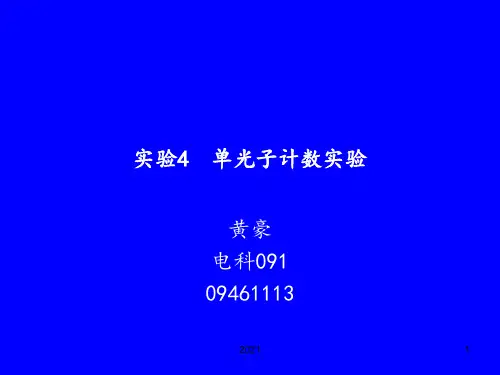

单光子探测技术在量子信息处理中的应用在量子信息处理中,单光子探测技术(Single Photon Detector,SPD)被广泛应用。
SPD可以用来检测光子的到达时间和强度,因此可以被用来构建高效的量子通信和计算设备。
在本文中,我们将探讨单光子探测技术在量子信息处理中的应用。
1. 单光子检测单光子检测是指通过测量光子的到达时间来检测光子。
在量子通信和计算中,单光子检测被用来构建安全的量子通信和量子密钥分发系统。
在量子密钥分发系统中,两个通信方使用单光子检测器来检测从单个光源发出的光子,以确保安全通信。
2. 确定光子的位置单光子探测器不仅可以用来检测光子的到达时间,还可以确定光子的位置。
在量子计算中,光子被用来携带信息,因此确定光子的位置对于构建高效的量子计算设备至关重要。
单光子探测器可以用来确定光子的位置,从而帮助量子计算机高效地进行计算。
3. 量子成像量子成像是指使用光子来成像物体的技术。
在传统成像技术中,使用的是大量的光子来成像物体。
但在量子成像技术中,只使用单个光子来成像物体。
这种技术可以用来实现高分辨率的图像成像,在医学和生物学领域中有广泛应用。
4. 光子计数在量子通信和计算中,光子计数是一种重要的测量技术。
光子计数是指通过计数光子的数量来确定某种量的值。
例如,在量子计算中,如果我们想要知道一个量子比特的概率,可以使用光子计数器来计算。
这种技术对于量子计算的正确性和可靠性至关重要。
5. 结语单光子探测技术在量子信息处理中的应用非常广泛。
它可以被用来检测光子的到达时间和强度,确定光子的位置,实现高分辨率的图像成像,以及计数光子的数量。
这些技术对于构建高效的量子通信和计算设备至关重要。
随着单光子探测技术的不断发展,我们相信它将会在未来的量子计算和通信中扮演更加重要的角色。
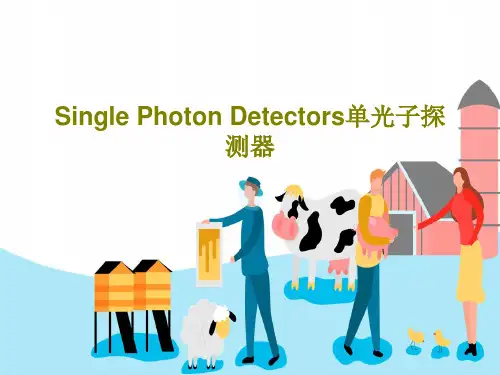
单光子探测器基本概念单光子探测器:(SPD)是一种超低噪声器件,增强的灵敏度使其能够探测到光的最小能量量子——光子。
单光子探测器可以对单个光子进行探测和计数,在许多可获得的信号强度仅为几个光子能量级的新兴应用中,单光子探测器可以一展身手。
光子,是光的最小能量量子。
单光子探测技术,是近些年刚刚起步的一种新式光电探测技术,其原理是利用新式光电效应,可对入射的单个光子进行计数,以实现对极微弱目标信号的探测。
光子计数也就是光电子计数,是微弱光(低于10-14W)信号探测中的一种新技术。
研究背景通常的直流检测方法不能把淹没在噪声中的信号提取出来。
微弱光检测的方法有:锁频放大技术、锁相放大技术和单光子计数方法。
最早发展的锁频,原理是使放大器中心频率f0与待测信号频率相同,从而对噪声进行抑制。
但这种方法存在中心频率不稳、带宽不能太窄、对待测信号缺乏跟踪能力等缺点。
后来发展了锁相,它利用待测信号和参考信号的互相关检测原理实现对信号的窄带化处理,能有效的抑制噪声,实现对信号的检测和跟踪。
但是,当噪声与信号有同样频谱时就无能为力,另外它还受模拟积分电路漂移的影响,因此在弱光测量中受到一定的限制。
单光子计数方法,是利用弱光照射下光电倍增管输出电流信号自然离散化的特征,采用了脉冲高度甄别技术和数字计数技术光子计数原理1、光子光是由光子组成的光子流,光子是静止质量为零、有一定能量的粒子。
与一定的频率υ相对应,一个光子的能量E p可由下式决定:E p=hυ=hc/λ(15-1)式中c=3×108m/s,是真空中的光速;h=6.6×10-34J·s,是普朗克常数。
例如,实验中所用的光源波长为λ=5000Å的近单色光,则E p =3.96×10-19J。
光流强度常用光功率P表示,单位为W。
单色光的光功率与光子流量R(单位时间内通过某一截面的光子数目)的关系为:P=R·E p (15-2)所以,只要能测得光子的流量R,就能得到光流强度。